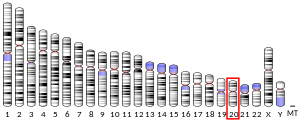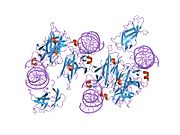NFATC2
Nuclear factor of activated T-cells, cytoplasmic 2 is a protein that in humans is encoded by the NFATC2 gene.[5]
Function
[edit]This gene is a member of the nuclear factor of activated T cells (NFAT) family. The product of this gene is a DNA-binding protein with a REL-homology region (RHR) and an NFAT-homology region (NHR). This protein is present in the cytosol and only translocates to the nucleus upon T cell receptor (TCR) stimulation, where it becomes a member of the nuclear factors of activated T cells transcription complex. This complex plays a central role in inducing gene transcription during the immune response. Alternate transcriptional splice variants, encoding different isoforms, have been characterized.[6]
Clinical significance
[edit]Translocation forming an in frame fusions product between EWSR1 gene and the NFATc2 gene has been described in bone tumor with a Ewing sarcoma-like clinical appearance. The translocation breakpoint led to the loss of the controlling elements of the NFATc2 protein and the fusion of the N terminal region of the EWSR1 gene conferred constant activation of the protein.[7]
Interactions
[edit]NFATC2 has been shown to interact with MEF2D,[8] EP300,[9] IRF4[10] and Protein kinase Mζ.[11] Prostaglandin F2alpha stimulates a NFCT2 pathway stimulating growth of skeletal muscle cells.[12]
References
[edit]- ^ a b c GRCh38: Ensembl release 89: ENSG00000101096 – Ensembl, May 2017
- ^ a b c GRCm38: Ensembl release 89: ENSMUSG00000027544 – Ensembl, May 2017
- ^ "Human PubMed Reference:". National Center for Biotechnology Information, U.S. National Library of Medicine.
- ^ "Mouse PubMed Reference:". National Center for Biotechnology Information, U.S. National Library of Medicine.
- ^ Northrop JP, Ho SN, Chen L, Thomas DJ, Timmerman LA, Nolan GP, Admon A, Crabtree GR (Jun 1994). "NF-AT components define a family of transcription factors targeted in T-cell activation". Nature. 369 (6480): 497–502. Bibcode:1994Natur.369..497N. doi:10.1038/369497a0. PMID 8202141. S2CID 9920546.
- ^ "Entrez Gene: NFATC2 nuclear factor of activated T-cells, cytoplasmic, calcineurin-dependent 2".
- ^ Szuhai K, Ijszenga M, de Jong D, Karseladze A, Tanke HJ, Hogendoorn PC (Apr 2009). "The NFATc2 gene is involved in a novel cloned translocation in a Ewing sarcoma variant that couples its function in immunology to oncology". Clinical Cancer Research. 15 (7): 2259–68. doi:10.1158/1078-0432.CCR-08-2184. PMID 19318479.
- ^ Youn HD, Chatila TA, Liu JO (Aug 2000). "Integration of calcineurin and MEF2 signals by the coactivator p300 during T-cell apoptosis". The EMBO Journal. 19 (16): 4323–31. doi:10.1093/emboj/19.16.4323. PMC 302027. PMID 10944115.
- ^ García-Rodríguez C, Rao A (Jun 1998). "Nuclear factor of activated T cells (NFAT)-dependent transactivation regulated by the coactivators p300/CREB-binding protein (CBP)". The Journal of Experimental Medicine. 187 (12): 2031–6. doi:10.1084/jem.187.12.2031. PMC 2212364. PMID 9625762.
- ^ Rengarajan J, Mowen KA, McBride KD, Smith ED, Singh H, Glimcher LH (Apr 2002). "Interferon regulatory factor 4 (IRF4) interacts with NFATc2 to modulate interleukin 4 gene expression". The Journal of Experimental Medicine. 195 (8): 1003–12. doi:10.1084/jem.20011128. PMC 2193700. PMID 11956291.
- ^ San-Antonio B, Iñiguez MA, Fresno M (Jul 2002). "Protein kinase Czeta phosphorylates nuclear factor of activated T cells and regulates its transactivating activity". The Journal of Biological Chemistry. 277 (30): 27073–80. doi:10.1074/jbc.M106983200. PMID 12021260.
- ^ Horsley V, Pavlath GK (2003). "Prostaglandin F2(alpha) stimulates growth of skeletal muscle cells via an NFATC2-dependent pathway". J Cell Biol. 161 (1): 111–8. doi:10.1083/jcb.200208085. PMC 2172881. PMID 12695501.
Further reading
[edit]- Rao A, Luo C, Hogan PG (1997). "Transcription factors of the NFAT family: regulation and function". Annual Review of Immunology. 15: 707–747. doi:10.1146/annurev.immunol.15.1.707. PMID 9143705.
- Crabtree GR (Mar 1999). "Generic signals and specific outcomes: signaling through Ca2+, calcineurin, and NF-AT". Cell. 96 (5): 611–614. doi:10.1016/S0092-8674(00)80571-1. PMID 10089876. S2CID 8817053.
- Horsley V, Pavlath GK (Mar 2002). "NFAT: ubiquitous regulator of cell differentiation and adaptation". The Journal of Cell Biology. 156 (5): 771–774. doi:10.1083/jcb.200111073. PMC 2173310. PMID 11877454.
- Aramburu J, Azzoni L, Rao A, Perussia B (Sep 1995). "Activation and expression of the nuclear factors of activated T cells, NFATp and NFATc, in human natural killer cells: regulation upon CD16 ligand binding". The Journal of Experimental Medicine. 182 (3): 801–810. doi:10.1084/jem.182.3.801. PMC 2192167. PMID 7650486.
- Auffray C, Behar G, Bois F, Bouchier C, Da Silva C, Devignes MD, Duprat S, Houlgatte R, Jumeau MN, Lamy B (Feb 1995). "[IMAGE: molecular integration of the analysis of the human genome and its expression]". Comptes Rendus de l'Académie des Sciences, Série III. 318 (2): 263–72. PMID 7757816.
- Li X, Ho SN, Luna J, Giacalone J, Thomas DJ, Timmerman LA, Crabtree GR, Francke U (1995). "Cloning and chromosomal localization of the human and murine genes for the T-cell transcription factors NFATc and NFATp". Cytogenetics and Cell Genetics. 68 (3–4): 185–191. doi:10.1159/000133910. PMID 7842733.
- Ho S, Timmerman L, Northrop J, Crabtree GR (1994). "Cloning and Characterization of NF-ATc and NF-ATp: The Cytoplasmic Components of NF-AT". Mechanisms of Lymphocyte Activation and Immune Regulation V. Advances in Experimental Medicine and Biology. Vol. 365. pp. 167–73. doi:10.1007/978-1-4899-0987-9_17. ISBN 978-1-4899-0989-3. PMID 7887301.
- Jabado N, Le Deist F, Fisher A, Hivroz C (Nov 1994). "Interaction of HIV gp120 and anti-CD4 antibodies with the CD4 molecule on human CD4+ T cells inhibits the binding activity of NF-AT, NF-kappa B and AP-1, three nuclear factors regulating interleukin-2 gene enhancer activity". European Journal of Immunology. 24 (11): 2646–2652. doi:10.1002/eji.1830241112. PMID 7957556. S2CID 30435577.
- Vacca A, Farina M, Maroder M, Alesse E, Screpanti I, Frati L, Gulino A (Nov 1994). "Human immunodeficiency virus type-1 tat enhances interleukin-2 promoter activity through synergism with phorbol ester and calcium-mediated activation of the NF-AT cis-regulatory motif". Biochemical and Biophysical Research Communications. 205 (1): 467–474. doi:10.1006/bbrc.1994.2689. PMID 7999066.
- Jain J, McCaffrey PG, Miner Z, Kerppola TK, Lambert JN, Verdine GL, Curran T, Rao A (Sep 1993). "The T-cell transcription factor NFATp is a substrate for calcineurin and interacts with Fos and Jun". Nature. 365 (6444): 352–355. Bibcode:1993Natur.365..352J. doi:10.1038/365352a0. PMID 8397339. S2CID 4283223.
- Luo C, Burgeon E, Carew JA, McCaffrey PG, Badalian TM, Lane WS, Hogan PG, Rao A (Jul 1996). "Recombinant NFAT1 (NFATp) is regulated by calcineurin in T cells and mediates transcription of several cytokine genes". Molecular and Cellular Biology. 16 (7): 3955–66. doi:10.1128/mcb.16.7.3955. PMC 231392. PMID 8668213.
- Di Somma MM, Majolini MB, Burastero SE, Telford JL, Baldari CT (Sep 1996). "Cyclosporin A sensitivity of the HIV-1 long terminal repeat identifies distinct p56lck-dependent pathways activated by CD4 triggering". European Journal of Immunology. 26 (9): 2181–2188. doi:10.1002/eji.1830260933. PMID 8814265. S2CID 23430217.
- Copeland KF, McKay PJ, Rosenthal KL (Jan 1996). "Suppression of the human immunodeficiency virus long terminal repeat by CD8+ T cells is dependent on the NFAT-1 element". AIDS Research and Human Retroviruses. 12 (2): 143–148. doi:10.1089/aid.1996.12.143. PMID 8834464.
- Bonaldo MF, Lennon G, Soares MB (Sep 1996). "Normalization and subtraction: two approaches to facilitate gene discovery". Genome Research. 6 (9): 791–806. doi:10.1101/gr.6.9.791. PMID 8889548.
- Hodge MR, Chun HJ, Rengarajan J, Alt A, Lieberson R, Glimcher LH (Dec 1996). "NF-AT-Driven interleukin-4 transcription potentiated by NIP45". Science. 274 (5294): 1903–1905. Bibcode:1996Sci...274.1903H. doi:10.1126/science.274.5294.1903. PMID 8943202. S2CID 29436825.
- Lyakh L, Ghosh P, Rice NR (May 1997). "Expression of NFAT-family proteins in normal human T cells". Molecular and Cellular Biology. 17 (5): 2475–84. doi:10.1128/mcb.17.5.2475. PMC 232096. PMID 9111316.
- Amasaki Y, Masuda ES, Imamura R, Arai K, Arai N (Mar 1998). "Distinct NFAT family proteins are involved in the nuclear NFAT-DNA binding complexes from human thymocyte subsets". Journal of Immunology. 160 (5): 2324–33. doi:10.4049/jimmunol.160.5.2324. PMID 9498773. S2CID 19932048.
- Chen L, Glover JN, Hogan PG, Rao A, Harrison SC (Mar 1998). "Structure of the DNA-binding domains from NFAT, Fos and Jun bound specifically to DNA". Nature. 392 (6671): 42–48. Bibcode:1998Natur.392...42C. doi:10.1038/32100. PMID 9510247. S2CID 4305535.
External links
[edit]- NFATC2+protein,+human at the U.S. National Library of Medicine Medical Subject Headings (MeSH)
This article incorporates text from the United States National Library of Medicine, which is in the public domain.











